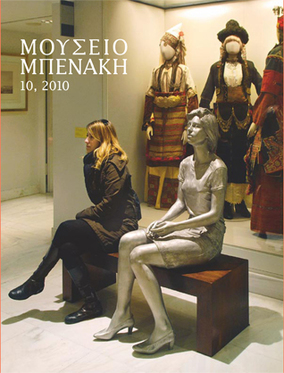"Και έγεινε φως" : Δύο μεσοβυζαντινά πολυκάνδηλα του Μουσείου Μπενάκη
Part of : Μουσείο Μπενάκη ; Vol.8, 2008, pages 91-115
Issue:
Pages:
91-115
Parallel Title:
Two Byzantine brass polykandela in the Benaki Museum
Section Title:
Articles
Author:
Abstract:
In the summer of 2008 Stylianos Liangis donated two Byzantine brass polykandela in memory of Iphigeneia Liangi. The objects had been acquired at an auction held by the art dealers Royal-Athena Galleries and Bonhams, where the two auction houses had dated the polykandela to the sixth-seventh centuries. They were incorporated into the Museum’s Byzantine Collection under the inventory numbers 44724 and 44725 respectively and transferred to the museum’s Metals Conservation Laboratory, where they were conserved prior to being displayed in the museum’s permanent exhibition. Despoina Kotzamani, head of the Metals, Glass and Bony Conservation Laboratory carried out the necessary analyses on the composition of the metal in order to ascertain the base material and the method of construction used, and to provide a dating for the objects on the basis of the alloys they used.The purpose of this study is to assign the two objects to the appropriate categories of lighting devices on the basis of their construction and decoration, using the extensive range of comparative material at our disposal. The question of dating will require considerable attentionas the polykandela belong to a category of brass objectswhich comes into use in the sixth century and continuesin use to the end of the thirteenth century. Moreover thedifficulty of dating the objects is partly due to the fact thatthe dating of the suspension chains is not always consistent with that of the discs, as they may constitute two distinctobjects as the result of separation.The first brass polykandelon (inv. no. 44724) to be studiedis cast and consists of a pierced disc, three chains and asuspension ring (figs 1-3). The chain is 45 cm long while thedisc has a diameter of 30.9 cm and nine openings, in whichglass oil lamps would have been placed. Three rings havebeen soldered to the upper surface of the disc by means ofwhich the chains are attached. The three suspension chainsend in a pierced Maltese cross. The chain which ends in thesuspension ring is attached to the upper arm of this cross.The second brass polykandelon (inv. no. 44725) is also castand consists of a pierced disc with three chains which end ina suspension ring (figs 4-6). It is 67.5 cm high and the dischas a diameter of 27.5 cm. The disc has six openings aroundits circumference for fitting the glass oil lamps. Three ringsare soldered to the upper surface of the disc, through whichthe hooks of the chains pass.A dating ofpolykandelon A (inv. no. 44724) in the nintheleventh century is confirmed by comparing it to the one inthe Averoff Collection (fig. 11) and another in the LouvreMuseum (fig. 10). The same applies to polykandelon B(inv. no. 44725), when it is compared with the one in theBritish Museum (fig. 16) and with a large group of lightingdevices from the Monastery of Saint Titos in Crete and thepolykandela from Kairouan. Added confirmation of thedating of the second polykandelon to the ninth-eleventhcentury comes from the comparative material which hasemerged from the excavations at Ravy and Beycesultan.On the basis of the dating of the Benaki Museum’spolykandela we can proceed to classify them in thecategories of objects proposed by Maria Xanthopoulouand compare them with similar Byzantine and Islamicexamples. It is important to note that a large number ofobjects have been re-dated in the light of new publicationsand archaeological finds. Motifs and patterns which weredescribed as “Byzantine” in the past have been shown to becloser to Islamic models, with the result that the influencethe two cultures exercised over one another can be seento be quite strong not just in the border areas of the twoempires but also in the hinterland.The Benaki Museum’s two polykandela are examples ofexceptional craftsmanship. Visitors to the museum cannothelp but be impressed, when they think about the wondersomeone coming to church to pray would have felt inexperiencing the illumination they provided.
Subject:
Subject (LC):




